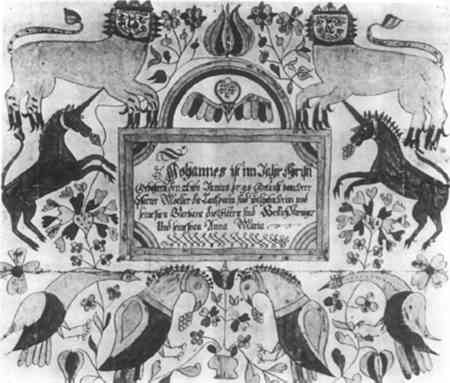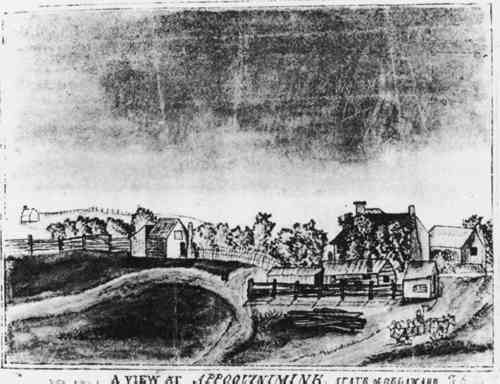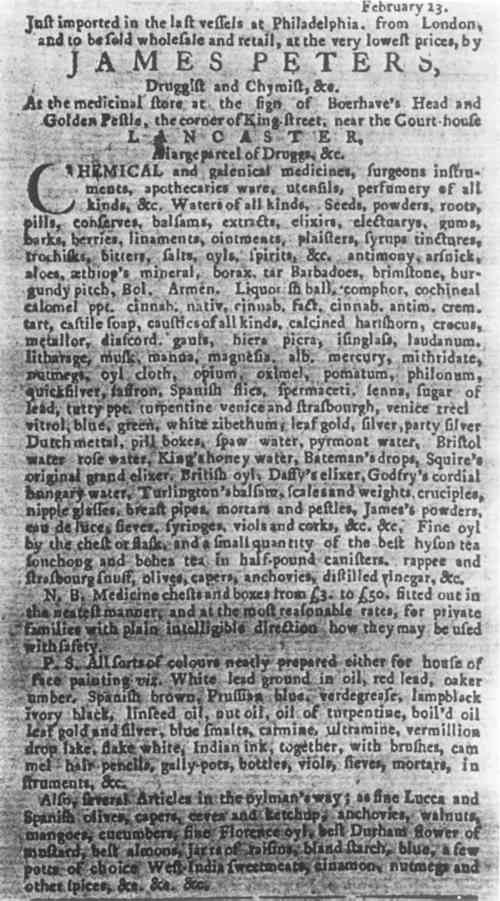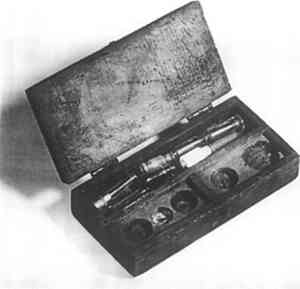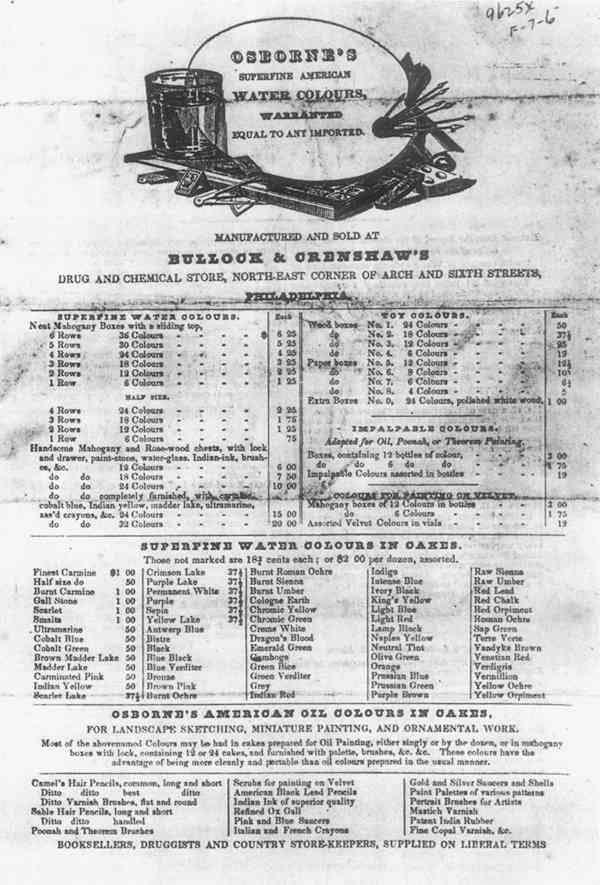PIGMENT ANALYSIS OF EARLY AMERICAN WATERCOLORS AND FRAKTURJanice H. Carlson, & John Krill
ABSTRACT—The X-ray fluorescence analysis of the pigments on eleven early American watercolors and sixteen fraktur, in three English and American paint boxes, and two fraktur painters' boxes, has established that both fraktur artists and their contemporary watercolorists used commercially available pigments. The availability of these pigments to both groups is noted not only by their actual use but also by historical evidence. 1 INTRODUCTIONTHE PAPER CONSERVATION and Analytical Laboratories of the Winterthur Museum have participated in a joint project involving analysis of the pigments used in fraktur and early American watercolors. The term fraktur properly describes a typeface popular in Germany from the sixteenth century and characterized by “fractured” letter forms. It now refers to the illuminated manuscripts of the Pennsylvania Germans, and other German settlers, made during the eighteenth and mid-nineteenth centuries as shown in Figure 1. In contrast is the second group, the watercolors, which are paintings by the rural early American people; see Figure 2.
The objective of this study was to use X-ray fluorescence analysis to identify the chemical elements found in the pigments used by both fraktur artists and early watercolorists. It was hoped that through interpretation of this elemental data, pigments used by both groups could be identified; and that this information would either confirm or lay to rest the idea of the fraktur artist using products of the early American farm environs for his pigments. In addition, the analytical data might help in the authentication of a given painting, since the presence of certain pigments might permit more accurate dating. 2 HISTORICAL BACKGROUNDTHE FIRST GROUP of Germans to arrive in Pennsylvania came in 1683, just two years after Charles II granted a charter for the land to William Penn. Some of them heard Penn speak on a missionary trip which he made to Germany in 1677; Penn, a zealous Quaker, saw Pennsylvania as a “Holy Experiment.” The Germans settled in what was aptly called Germantown, which remained the boundaries of their immigration until about 1710. By 1717, the incoming Germans had begun to generate concern in the predominently Quaker and English city of Philadelphia. In 1727, an estimated 15,000 to 20,000 Germans were living in the colony.1 The height of the immigration was reached around 1750 with as many as twenty-two ships of Germans arriving a year.2 Between 5 and 10% of these Germans were “plain people” such as the Amish and Mennonites; the majority of the rest were “church people” such as the Lutheran and Reformed. Interestingly, this latter group produced most of the fraktur. At mid-century The contributions of the eighteenth century German settlers were rich and varied. They provided much of the trade in the prominent and rich city of Philadelphia. They introduced many modern agricultural methods. Their printers produced more books than those of New England and New York combined. Benjamin Franklin began a German newspaper for them in 1732, and also in Philadelphia, cabinetmakers printed their message in English and German on the same furniture label. Education was important to the Germans. Communities are known to have built a schoolhouse before building a church. The penmanship sheets of writing specimens by the schoolmaster were teaching aids of the time. Awards of merit, too, were made by him. These manuscripts are fraktur. Other forms of fraktur include birth and baptismal certificates, house blessings and family records. The first person to write about fraktur and bring it toward the fore was Henry Mercer, who, in 1897, said the following about a paint box used for fraktur:
The implications from this, that fraktur were produced from farmyard products, have continued to the present day. Gilbert, in 1971, said, “Fortunately there were teachers trained in the art of fraktur who could instruct their pupils to write the alphabet and to illustrate the letters with homemade paints. Vegetable, plant, and berry dyes were probably used… .”5 Unfortunately glossed over by some was Mercer's comment in a catalog description in another presentation that, “the old paints were bought from apothecaries in Philadelphia and kept in bottles.”6 Among the scholars whose theories were that fraktur makers used known artist pigments is Frances Lichten. In a 1963 lecture on fraktur she said that she, as an artist, could easily recognize by eye the presence of such widely used pigments as vermilion, Prussian blue, gamboge and orpiment.7 Earlier, in 1937, Henry Borneman
Borneman shares with us Johann Krauss's Haus und Kunst-Buch published in 1819 in Allentown, Pennsylvania. Krauss wrote of the use of carmine, annotto, Prussian blue, verdigris, and other colors. Also presented by Borneman is Ambrosius Henkel's Das Grosze ABC Buch, published in New Market, Virginia, which recommends Brazil wood, verdigris, and indigo. Artists' colors were available to the countrymen through several sources. They came through local shops and peddlers, by special order from abroad (there was much correspondence to the homeland at that time) and from large cities. A newspaper advertisement, shown in Figure 3, in the Pennsylvania Journal, March 29, 1764, placed by James Peters, druggist and chemist in Lancaster, tells of items “Just imported in the last vessels at Philadelphia, from London… .” Included in the list are white lead, red lead, ocher, umber, Spanish brown, Prussian blue, verdigris, lamp black, ivory black, smalt, carmine, ultramarine, vermilion, flake white, and Indian ink.9 In the 1820's, domestic watercolors became available. These were first manufactured in America by the Osborne Company in Philadelphia.10
Also imported was paper. Since the beginning of the colonies, paper had arrived from abroad in a strong continous stream. The only major obstruction to this flow was from 1765 (the Stamp Act) through 1783 (the end of the American Revolution). After the war, paper resumed its course from Europe with such breadth that by the third decade of the nineteenth century its competition caused some drastic reductions in America's paper industry.11 That imported and domestic papers have been found used with fraktur is not surprising. Many early American paper-makers were Pennsylvania German, including the first, Wilhelm Rittenhouse, whose mill was erected near Germantown in 1690. So we see that the Pennsylvania Germans' use of imported papers and paints is in harmony with their other, often progressive, contributions to their new world. As a foreign traveler in the eighteenth century noted: they must have been princes as their barns were so big!12 3 PIGMENT ANALYSISELEMENTAL ANALYSIS by X-ray fluorescence was used in this study of painting materials. The technique, previously used in the determination of the chemical composition of silver, brass, pewter and glass,13, 14 was modified slightly for pigment analysis so While pigment samples could have been removed from the fraktur and watercolors being studied, we chose not to do so. Rather, our efforts were directed toward demonstrating the utility for pigment analysis of a technique already available in our laboratory. Without the removal of any sample, even the most minute, x-ray fluorescence analysis, although not providing a complete description of the pigment, frequently provided sufficient information on elemental composition to permit reliable conclusions as to the identity of pigments. Further, the rapidity of the technique permitted the analysis of more than 100 pigmented areas in only a few days time. X-ray fluorescence analysis does have certain limitations. Since the technique is not sensitive to elements below atomic number 19, pigments which are metal acetates, silicates, aluminates, etc. cannot be fully characterized. Similarly, organic dyes are not detected except by the absence of metal cations. If the pigmented area is small, the elements present in neighboring areas may obscure those in the area of interest. Finally, analytical data obtained on colors made of two or more pigments, e.g. Prussian blue mixed with an organic yellow to form green, may be subject to misinterpretation. The first step in attempting to resolve the controversy surrounding the source of fraktur painters' materials was to examine the pigments used by watercolor painters in the period 1750–1850. To this end, the pigments in three watercolor paint boxes in the Winterthur collection, and those of a group of non-fraktur American watercolors from the same time period were analyzed. Although the first box, of English origin, is itself authentic, dating from the late eighteenth century, analysis of the pigments showed that several of them were not available until sometime later. A yellow pigment, for example, contained both lead and chromium indicating it was chrome yellow (PbCrO4), a pigment which did not become available on a commercial scale until 1818. A second paint box (England, early nineteenth century) contained about forty watercolor cakes, rather than powdered pigments. The elemental compositions of these cakes are summarized in Table I. In a few instances in this Table as well as Table II, elements expected on the basis of the label identification are absent; in other cases, additional unexpected elements are present. More study on these is desirable but was not undertaken as part of this project. For the most part, the elements found in the pigment cakes and the pigment identifications based upon them are consistent with their attributed dates. TABLE I ELEMENTS FOUND—PAINT BOX (68.1828) REEVES & INWOOD—ENGLISH, 19TH CENTURY TABLE II ELEMENTS FOUND—PAINT BOX (65.1303) G. C. OSBORNE, PHILADELPHIA—AMERICAN C.1826 The third paint box examined was made by Osborne and Company of Philadelphia in 1826. Although the pigment cakes are fewer in number than in the Note among the pigments in the Osborne box (Table II) the presence of vermilion, Prussian blue, chrome yellow, several iron containing umbers and siennas, and others. Data from the analysis of the pigments of eleven non-fraktur watercolors, summarized in Table III and discussed below suggests, however, that even though large numbers of pigments were available, only a few were actually used to any extent. TABLE III PIGMENTS INDICATED ON ELEVEN WATERCOLORS AMERICAN, C.1700–1850
How do the pigments of fraktur compare with those found on early American watercolors? The findings on sixteen fraktur are summarized in Table IV and discussed below. TABLE IV PIGMENTS INDICATED ON SIXTEEN FRAKTUR AMERICAN, C.1780–1850
For further information on the pigments used, we turned to two fraktur painters boxes in the collection of the Mercer Museum17; see Figure 4. A blue material from one bottle was Prussian blue. Among the pigments found in the second box (Table V) were white lead, two samples of Prussian blue, chrome yellow, vermilion, and terra di Siena. The last color was previously found in one watercolor and the wooden English paint box. Its presence in one of these fraktur painter's boxes is particularly significant since it ties together both fraktur and non-fraktur watercolor paintings with a known commercially available but perhaps little used pigment.
TABLE V PIGMENTS FROM FRAKTUR PAINTER'S BOX MERCER MUSEUM NO. 25370 These data from the analysis of pigments on sixteen fraktur, together with those from the fraktur painters' bottles, refutes the idea that fraktur pigments came only from local farmlands and gardens. The confusion seems to have arisen from Henry Mercer's statement that the artist's paint bottles contained “home-mixed inks and paints”. Home-mixed—yes. The commercially bought powder or cake pigments were undoubtedly mixed with a medium or binder. These pigments were not, however, home-made, that is extracted from local plants and berries. 4 CONCLUSIONIN SUMMARY, the x-ray fluorescence analysis of the pigments on eleven early American watercolors, sixteen fraktur, in three English and American paint boxes, and two fraktur painters boxes has shown that both fraktur artists and their contemporary watercolorists, used commercially available pigments. The availability of these pigments also is noted by the historical evidence. Newspapers, furniture labels, advertisements and trade cards as shown in Figure 5 attest to the availability of a wide variety of commercial products from the trade centers of Philadelphia and Lancaster. Not the least among these were artistsa' painting materials. As a card by the Osborne Company, pigment makers of Philadelphia, states “Booksellers, Druggists and Country Storekeepers all supplied on liberal terms”.18
REFERENCESJoseph E.Illick, Colonial Pennsylvania: A History, (New York: Charles Scribner's Sons, 1976), p. 123. Russell WeidnerGilbert, A Picture of the Pennsylvania Germans, Pennsylvania History Studies: No. 1, (Gettysburg: The Pennsylvania Historical Association, 1971), 3rd edition, pp. 6–7. Gilbert, Pennsylvania Germans, p. 11–12. HenryMercer, “The Survival of the Medieval Art of Illuminative Writing Amoung Pennsylvania Germans”, (Proceedings of the American Philosophical Society, 36, no. 156 (1897), p. 424.), reprinted in Contributions to American History, No. 2, (Doylestown, Pa.: The Bucks County Historical Society). Gilbert, Pennsylvania Germans, p. 49. Henry C.Mercer, Tools of the Nationmaker, (Doylestown, Pa: Bucks County Intelligencer, 1897), p. 65. FrancesLichten, The Illuminated Manuscripts of the Pennsylvania Dutch, (Philadelphia: Free Library of Philadelphia, 1958), p. 24. HenryBorneman, “Pennsylvania German Illuminated Manuscripts”, Proceedings of the Pennsylvania German Society, 46, (1937), p. 41. Monroe H.Fabian, Associate Curator, National Portrait Gallery, Washington, D.C., personal letter. Lichten, Illuminated Manuscripts, p. 24. John W.Maxon, Jr., “American Papermakers in the Great Tariff Debate”, The Paper Maker, 31, no. 1 (1962), pp. 23–24. In 1820, the petition “The Memorial of the Society of Paper Makers of the States of Pennsylvania and Delaware” was presented to Congress. It reflected the times: The district we represent offers, we think, a comparative view of the state of this manufacture in the country at large—In this seventy Paper Mills, are erected which were in full operation, until the imporations after the late war; in these there were ninety-five paper vats…employing nine hundred and fifty persons…; and from the causes we have mentioned we find that there remain but seventeen vats at work… leaving unemployed 775 persons…. JosephKindigIII, introductory lecture to “The Pennsylvania German Influence on American Decorative Arts”, Pennsbury Manor Americana Forum, Pennsbury, Pennsylvania, September, 1977. V. F.Hanson, “Quantitative Elemental Analysis of Art Objects by Energy Dispersive X-ray Fluorescence Spectroscopy”, Applied Spectroscopy, 27, no. 5 (1973), pp. 309–334. J. H.Carlson, “X-ray Fluorescence Analysis of Pewter: English and Scottish Measures”, Archaeometry, 19, no. 2, (1977), pp. 147–155. J. R.Gettens and G. L.Stout, Painting Materials, A Short Encyclopedia, (New York: Dover, 1966). R. D.Harley, Artists' Pigments, c.1600–1835, (New York: American Elsevier, 1970). Grateful acknowledgement is made to the Mercer Museum, Doylestown, Pa., for the lending of the pigments for analysis. Trade Card (66 � 93.4), Osborne and Company, Philadelphia, c. 1843, The Joseph Downs Manuscript and Microfilm Collection, Winterthur Museum, Winterthur, Delaware.
 Section Index Section Index |
